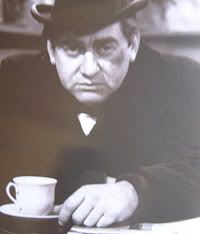Very Nearly An Armful
 Richard Webber has written a fascinating book to celebrate 50 years of Hancock's Half Hour. It's not an addition to the many books about Hancock himself but an incredibly detailed and scholarly work about how the radio and television programmes were written and made.
Richard Webber has written a fascinating book to celebrate 50 years of Hancock's Half Hour. It's not an addition to the many books about Hancock himself but an incredibly detailed and scholarly work about how the radio and television programmes were written and made.
It's the amazing productivity of the writers Galton and Simpson that sticks in the mind. 'Stakhanovite' doesn't begin to describe it. In seven years they wrote 103 radio episodes and 63 television shows. These days, when radio comedies transfer to television, their radio life is usually over. But the Hancock shows continued on radio for a long time with Galton and Simpson writing for both mediums simultaneously.
Because I was too young for the radio series to make much impact on me, I hadn't realised that, unlike the TV version, they were almost totally lacking in realism or continuity and were written more like a comic strip. One week Hancock was rich, another he was broke. One week he was a lawyer, another a test pilot. Radio audiences then were completely at ease in a world of fantasy.
It's hard to convey how super-famous people like Hancock were in an age of two channel television. The first TV series in 1956 started with an audience of six million. The final series in 1961 kicked off with over fourteen million. I wonder if Hancock or Galton and Simpson ever knew that in primary school playgrounds - well, mine anyway - we used to pay homage to the great man by pointing at body parts and reciting "Toe - Knee - Hand - Cock." We thought this incredibly rude and very funny, especially if you touched the other person's relevant parts as you said it. The girls couldn't join in, of course, and skipped or played hopscotch instead. Girls are so boring like that.
Besides being a nostalgia-fest for old farts like me, I think people working in TV today would be intrigued by the often ham-fisted way that programmes were made and the pressures and constraints of sitcoms going out live. In one TV episode, the set was designed to collapse in the final scene. Unfortunately, it started to fall apart from the beginning of the show so the cast had to remain static throughout while holding up the scenery. When the time came for the scripted collapse at the end, Hancock couldn't resist looking into the camera and saying "Surprise, surprise!"
One of the great mysteries of writing humour in any medium is how arranging specific words in a certain order can produce laughter. In many instances, changing one word or just changing the order of words removes the humour. There's an outstanding example of this in the book. Probably one of the most famous lines in comedy, from The Blood Donor, is: "A pint, that's very nearly an armful." Alan Simpson reveals that this began as "that's just about an armful." It took them about 15 minutes to settle on the final version, which is funnier because it's more precise and therefore even more ridiculous.
The conventional wisdom today is that you can teach anyone to do anything, including brain surgery and comedy writing. But I cling stubbornly to the belief that some people have a greater gift than others and are better able to recognise what works and what doesn't.
This reminds me of the stories about the poor sods who had to insert jokes into Mrs Thatcher's speeches. During one conference season, Jim Callaghan had compared himself to Moses. Thatcher's writers had written the admittedly not very funny line: "All I can say is, keep taking the tablets." "Or", said Thatcher, "I could say 'Keep taking the pills'". The thudding sound was her scriptwriters jumping off the hotel balcony.
Fifty Years of Hancock's Half Hour is published by Century (2004).

0 Comments:
Post a Comment
<< Home